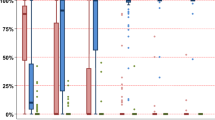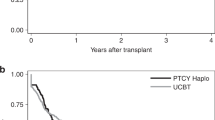Abstract
The main limitations to umbilical cord blood (UCB) transplantation (UCBT) in adults are delayed engraftment, poor immunological reconstitution and high rates of non-relapse mortality (NRM). Double UCBT (DUCBT) has been used to circumvent the issue of low cell dose, but acute GVHD remains a significant problem. We describe our experience in 32 subjects, who underwent DUCBT after reduced-intensity conditioning with fludarabine/melphalan/antithymocyte globulin and who received sirolimus and tacrolimus to prevent acute GVHD. Engraftment of neutrophils occurred in all patients at a median of 21 days, and platelet engraftment occurred at a median of 42 days. Three subjects had grade II–IV acute GVHD (9.4%) and chronic GVHD occurred in four subjects (cumulative incidence 12.5%). No deaths were caused by GVHD and NRM at 100 days was 12.5%. At 2 years, NRM, PFS and OS were 34.4, 31.2 and 53.1%, respectively. As expected, immunologic reconstitution was slow, but PFS and OS were associated with reconstitution of CD4+ and CD8+ lymphocyte subsets, suggesting that recovery of adaptive immunity is required for the prevention of infection and relapse after transplantation. In summary, sirolimus and tacrolimus provide excellent GVHD prophylaxis in DUCBT, and this regimen is associated with low NRM after DUCBT.
This is a preview of subscription content, access via your institution
Access options
Subscribe to this journal
Receive 12 print issues and online access
$259.00 per year
only $21.58 per issue
Buy this article
- Purchase on Springer Link
- Instant access to full article PDF
Prices may be subject to local taxes which are calculated during checkout




Similar content being viewed by others
References
Laughlin MJ, Eapen M, Rubinstein P, Wagner JE, Zhang MJ, Champlin RE et al. Outcomes after transplantation of cord blood or bone marrow from unrelated donors in adults with leukemia. N Engl J Med 2004; 351: 2265–2275.
Rocha V, Labopin M, Sanz G, Arcese W, Schwerdtfeger R, Bosi A et al. Transplants of umbilical-cord blood or bone marrow from unrelated donors in adults with acute leukemia. N Engl J Med 2004; 351: 2276–2285.
Ballen KK, Spitzer TR, Yeap BY, McAfee S, Dey BR, Attar E et al. Double unrelated reduced-intensity umbilical cord blood transplantation in adults. Biol Blood Marrow Transplant 2007; 13: 82–89.
Brunstein CG, Barker JN, Weisdorf DJ, DeFor TE, Miller JS, Blazar BR et al. Umbilical cord blood transplantation after nonmyeloablative conditioning: impact on transplantation outcomes in 110 adults with hematologic disease. Blood 2007; 110: 3064–3070.
MacMillan ML, Weisdorf DJ, Brunstein CG, Cao Q, DeFor TE, Verneris MR et al. Acute graft-versus-host disease after unrelated donor umbilical cord blood transplantation: analysis of risk factors. Blood 2009; 113: 2410–2415.
Sehgal SN . Sirolimus: its discovery, biological properties, and mechanism of action. Transplant Proc 2003; 35 (3 Suppl): S7–S14.
Wang GY, Chen GH, Li H, Huang Y, Wang GS, Jiang N et al. Rapamycin-treated mature dendritic cells have a unique cytokine secretion profile and impaired allostimulatory capacity. Transpl Int 2009; 22: 1005–1016.
Cutler C, Li S, Ho VT, Koreth J, Alyea E, Soiffer RJ et al. Extended follow-up of methotrexate-free immunosuppression using sirolimus and tacrolimus in related and unrelated donor peripheral blood stem cell transplantation. Blood 2007; 109: 3108–3114.
Marty FM, Bryar J, Browne SK, Schwarzberg T, Ho VT, Bassett IV et al. Sirolimus-based graft-versus-host disease prophylaxis protects against cytomegalovirus reactivation after allogeneic hematopoietic stem cell transplantation: a cohort analysis. Blood 2007; 110: 490–500.
Rubinstein P, Dobrila L, Rosenfield RE, Adamson JW, Migliaccio G, Migliaccio AR et al. Processing and cryopreservation of placental/umbilical cord blood for unrelated bone marrow reconstitution. Proc Natl Acad Sci USA 1995; 92: 10119–10122.
Przepiorka D, Weisdorf D, Martin P, Klingemann HG, Beatty P, Hows J et al. 1994 Consensus Conference on Acute GVHD Grading. Bone Marrow Transplant 1995; 15: 825–828.
Douek DC, McFarland RD, Keiser PH, Gage EA, Massey JM, Haynes BF et al. Changes in thymic function with age and during the treatment of HIV infection. Nature 1998; 396: 690–695.
Kaplan E, Meier P . Nonparametric estimation from incomplete observations. J Am Stat Assoc 1958; 53: 457–481.
Rodrigues CA, Sanz G, Brunstein CG, Sanz J, Wagner JE, Renaud M et al. Analysis of risk factors for outcomes after unrelated cord blood transplantation in adults with lymphoid malignancies: A Study by the Eurocord-Netcord and Lymphoma Working Party of the European Group for Blood and Marrow Transplantation. J Clin Oncol 2009; 27: 256–263.
Cutler C, Henry NL, Magee C, Li S, Kim HT, Alyea E et al. Sirolimus and thrombotic microangiopathy after allogeneic hematopoietic stem cell transplantation. Biol Blood Marrow Transplant 2005; 11: 551–557.
Cutler C, Stevenson K, Kim HT, Richardson P, Ho VT, Linden E et al. Sirolimus is associated with veno-occlusive disease of the liver after myeloablative allogeneic stem cell transplantation. Blood 2008; 112: 4425–4431.
Brunstein CG, Cantero S, Cao Q, Majhail N, McClune B, Burns LJ et al. Promising progression-free survival for patients low and intermediate grade lymphoid malignancies after nonmyeloablative umbilical cord blood transplantation. Biol Blood Marrow Transplant 2009; 15: 214–222.
Armand P, Gannamaneni S, Kim HT, Cutler CS, Ho VT, Koreth J et al. Improved survival in lymphoma patients receiving sirolimus for graft-versus-host disease prophylaxis after allogeneic hematopoietic stem-cell transplantation with reduced-intensity conditioning. J Clin Oncol 2008; 26: 5767–5774.
Costa LJ . Aspects of mTOR biology and the use of mTOR inhibitors in non-Hodgkin's lymphoma. Cancer Treat Rev 2007; 33: 78–84.
Ho VT, Soiffer RJ . The history and future of T-cell depletion as graft-versus-host disease prophylaxis for allogeneic hematopoietic stem cell transplantation. Blood 2001; 98: 3192–3204.
Brunstein CG, Weisdorf DJ, DeFor T, Barker JN, Tolar J, van Burik JA et al. Marked increased risk of Epstein-Barr virus-related complications with the addition of antithymocyte globulin to a nonmyeloablative conditioning prior to unrelated umbilical cord blood transplantation. Blood 2006; 108: 2874–2880.
Mathew T, Kreis H, Friend P . Two-year incidence of malignancy in sirolimus-treated renal transplant recipients: results from five multicenter studies. Clin Transplant 2004; 18: 446–449.
Kirk AD, Cherikh WS, Ring M, Burke G, Kaufman D, Knechtle SJ et al. Dissociation of depletional induction and posttransplant lymphoproliferative disease in kidney recipients treated with alemtuzumab. Am J Transplant 2007; 7: 2619–2625.
Krams SM, Martinez OM . Epstein-Barr virus, rapamycin, and host immune responses. Curr Opin Organ Transplant 2008; 13: 563–568.
Nepomuceno RR, Balatoni CE, Natkunam Y, Snow AL, Krams SM, Martinez OM . Rapamycin inhibits the interleukin 10 signal transduction pathway and the growth of Epstein Barr virus B-cell lymphomas. Cancer Res 2003; 63: 4472–4480.
Kinch A, Öberg G, Arvidson J, Falk KI, Linde A, Pauksens K . Post-transplant lymphoproliferative disease and other Epstein-Barr virus diseases in allogeneic haematopoietic stem cell transplantation after introduction of monitoring of viral load by polymerase chain reaction. Scand J Infect Dis 2007; 39: 235–244.
Hochberg EP, Chillemi AC, Wu CJ, Neuberg D, Canning C, Hartman K et al. Quantitation of T-cell neogenesis in vivo after allogeneic bone marrow transplantation in adults. Blood 2001; 98: 1116–1121.
Lewin SR, Heller G, Zhang L, Rodrigues E, Skulsky E, van den Brink MR et al. Direct evidence for new T-cell generation by patients after either T-cell-depleted or unmodified allogeneic hematopoietic stem cell transplantations. Blood 2002; 100: 2235–2242.
Talvensaari K, Clave E, Douay C, Rabian C, Garderet L, Busson M et al. A broad T-cell repertoire diversity and an efficient thymic function indicate a favorable long-term immune reconstitution after cord blood stem cell transplantation. Blood 2002; 99: 1458–1464.
Weinberg K, Blazar BR, Wagner JE, Agura E, Hill BJ, Smogorzewska M et al. Factors affecting thymic function after allogeneic hematopoietic stem cell transplantation. Blood 2001; 97: 1458–1466.
Komanduri KV, St John LS, de Lima M, McMannis J, Rosinski S, McNiece I et al. Delayed immune reconstitution after cord blood transplantation is characterized by impaired thymopoiesis and late memory T-cell skewing. Blood 2007; 110: 4543–4551.
Beziat V, Nguyen S, Lapusan S, Hervier B, Dhedin N, Bories D et al. Fully functional NK cells after unrelated cord blood transplantation. Leukemia 2009; 23: 721–728.
Acknowledgements
Supported by NCI P01 CA142106, NCI R01 CA123855, the Jock and Bunny Adams Research and Education Fund, and the Ted and Eileen Pasquarello Research Fund. Funded in part by unrestricted research grants from Astellas, Inc and Genzyme, Inc. CC is supported by the Stem Cell Cyclists of the Pan Mass Challenge.
Author information
Authors and Affiliations
Corresponding author
Ethics declarations
Competing interests
The authors declare no conflict of interest.
Rights and permissions
About this article
Cite this article
Cutler, C., Stevenson, K., Kim, H. et al. Double umbilical cord blood transplantation with reduced intensity conditioning and sirolimus-based GVHD prophylaxis. Bone Marrow Transplant 46, 659–667 (2011). https://doi.org/10.1038/bmt.2010.192
Received:
Revised:
Accepted:
Published:
Issue Date:
DOI: https://doi.org/10.1038/bmt.2010.192
Keywords
This article is cited by
-
Engraftment kinetics after transplantation of double unit cord blood grafts combined with haplo-identical CD34+ cells without antithymocyte globulin
Leukemia (2021)
-
A phase II study of reduced intensity double umbilical cord blood transplantation using fludarabine, melphalan, and low dose total body irradiation
Bone Marrow Transplantation (2020)
-
Neurologic complications after allogeneic hematopoietic stem cell transplantation: risk factors and impact
Bone Marrow Transplantation (2018)
-
Conditioning regimens for allogeneic hematopoietic stem cell transplants in acute myeloid leukemia
Bone Marrow Transplantation (2017)
-
GvHD after umbilical cord blood transplantation for acute leukemia: an analysis of risk factors and effect on outcomes
Bone Marrow Transplantation (2017)



